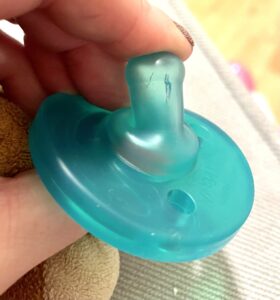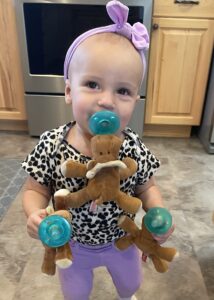Pacifier uses with babies, toddlers and kids
 Pacifiers can be a lifesaver for parents. Does your baby love their pacifier? Most babies do, and there is a good reason. Babies are born with a strong need to suck, and pacifiers help satisfy that need. They are great to use between meals, during a flight to help with the pressure changes during take-off and landing, and when getting shots or other medical treatments. Pacifiers also help babies to fall asleep at night and during naps, and they help to soothe them when fussy. Pacifiers can be helpful when going through transitions, like a new baby, going to daycare, or moving to a new home.
Pacifiers can be a lifesaver for parents. Does your baby love their pacifier? Most babies do, and there is a good reason. Babies are born with a strong need to suck, and pacifiers help satisfy that need. They are great to use between meals, during a flight to help with the pressure changes during take-off and landing, and when getting shots or other medical treatments. Pacifiers also help babies to fall asleep at night and during naps, and they help to soothe them when fussy. Pacifiers can be helpful when going through transitions, like a new baby, going to daycare, or moving to a new home.
Sucking is important as it helps babies feel safe. Unfortunately, sucking on a pacifier for more than two years is more likely to cause crowded teeth and change the way the jaw forms. And when this happens, your child will more likely become a mouth breather. Mouth breathing is common, but it is NOT normal. More on mouth breathing for another blog post.
As you can see, there are some great benefits to using a pacifier, and even The American Academy of Pediatrics (AAP) recommends using pacifiers until age one. And they say that using a pacifier during sleep can help reduce the risk of sudden infant death syndrome (SIDS). Breastfeeding has also been shown to reduce the risk of SIDS, and when breastfeeding, it is recommended not to use a pacifier until your baby is 3-4 weeks old or breastfeeding is going well. Always discuss with your pediatrician.
Let’s look at best practices when using pacifiers:
- Make sure only to use pacifiers made from one piece, those made with more than one piece are more likely to break and become a choking hazard.
- The nipple should be soft, and the shield should be at least 1 ½ inches wide so that the baby cannot put the whole pacifier in the mouth. The shield should have air holes.
 It is important to check your child’s pacifier regularly to make sure nothing is breaking down that could make it a safety risk. Look for discolored areas, holes or tears in the nipple, a stretched nipple, jagged or rough areas on the plastic, the nipple is sticky, or any loose pieces.
It is important to check your child’s pacifier regularly to make sure nothing is breaking down that could make it a safety risk. Look for discolored areas, holes or tears in the nipple, a stretched nipple, jagged or rough areas on the plastic, the nipple is sticky, or any loose pieces.- There are different sizes for different size babies and toddlers. Make sure to find the best fit as your child grows.
- Don’t use nipples from baby bottles as a pacifier, as they can pop out and cause a choking hazard.
- Before first use, boil or clean in the dishwasher (Make sure it is dishwasher safe). Squeeze any extra water out of the nipple so as not to burn the baby. These two methods are great ways to clean the pacifier for the first six months of life. A baby is more susceptible to germs in the first six months of life.
- When the pacifier falls on the floor, best NOT to clean it by putting it in your mouth. This will only give your baby more germs. If you can, carry an extra until you can wash the dirty one.
- After six months old, just clean with soap and water.
- Silicone pacifiers collect less bacteria than those made with latex, so you might want to look for those made of silicone.
- WubbaNub and other pacifiers with a stuffed animal attached are only meant to be used for the first six months. Once teeth come in, there is more chance that with a stuffy attached that the teeth can tear the nipple.
- There should not be any stuffed animals in the crib or other place where your child sleeps, so it is important if you do have one with a stuffy attached to switch to a pacifier without during sleeping times.
- Don’t cut the tip of the nipple. This will make it unsafe.
- Never tie one to the neck or wrist of the baby, as this can increase the risk of choking.
- Don’t put anything on the pacifier like sugar, honey, or other sweetened items as they can increase the risk of tooth decay.
- When teething, you can start to use teething rings/toys during the day instead of a pacifier to help with teething and for beginning to wean from the pacifier at age one.
Trying to choose a pacifier?
- The Soothie pacifier for newborn to 3 months helps promote the natural development of teeth and gums. It has been rated # 1 for newborns.
- Here is a website with a review of other pacifiers.
 As babies get older and become toddlers, pacifiers are often used more for emotional discomfort. This is a great time to give support instead of the pacifier. It can be draining to hear a toddler screaming and crying and not knowing how to calm them. Sometimes, they just need our love, hugs, and to know that we are there for them. The older your child gets, the more challenging It can be to wean them from their pacifier. And if they lose it in the night, often parents need to retrieve it and put it back in their mouth.
As babies get older and become toddlers, pacifiers are often used more for emotional discomfort. This is a great time to give support instead of the pacifier. It can be draining to hear a toddler screaming and crying and not knowing how to calm them. Sometimes, they just need our love, hugs, and to know that we are there for them. The older your child gets, the more challenging It can be to wean them from their pacifier. And if they lose it in the night, often parents need to retrieve it and put it back in their mouth.
If your child still has a pacifier by age three, you may need to help them give it up.
Ideas to start weaning or giving up the pacifier:
- Distract them with an activity when they likely would ask for their pacifier.
- Think ahead to when you are doing errands and may have to wait in line – you might want to bring a book or easy to carry toy.
- Play a game like I spy or make up a silly story to offer a distraction.
- Find some new lovey that you can give them for cuddling. It could be a blanket, stuffed animal, doll, or another toy.
- A trip to the store to pick out a new toy in exchange for their pacifier can do the trick.
- You might want to start by slowly decreasing the time your child has their pacifier, maybe only for naps and nighttime, and not at all during the day.
- Tell them something positive, like, “you are doing so great and don’t need your pacifier anymore since you are a big kid.”
- You can use a chart or calendar to put check marks on showing the days of no pacifier use and have a goal of a prize after a specific time period.
- It can be helpful for your child to hear from someone else, like their dental provider, that it is time to give it up.
- Do a celebration to say goodbye to the pacifier. Don’t do this when there is a lot of stress or change in the family. Wait until things settle down.
- Some people choose to just get rid of the pacifier and stop all at once. For some families, this can be stressful and might not be best for them.
- Talking ahead of time and picking a date such as their 3rd birthday can help them to work up to it.
- Give it away to someone having babies or at the doctor’s office for all the new babies (only you know it won’t be given to other people).
- The pacifier fairy can come and trade it for a gift.
- If giving it up isn’t working well, there are safe products to put on the pacifier that do not taste good. Talk to your pediatrician about what is best to buy
 We lost my younger daughters by mistake, and this is a method that worked well for us. My other daughter found her thumb, which is much harder to stop since you can’t throw it away or give it away! We finally read a book called “David Decides,” which helped a lot.
We lost my younger daughters by mistake, and this is a method that worked well for us. My other daughter found her thumb, which is much harder to stop since you can’t throw it away or give it away! We finally read a book called “David Decides,” which helped a lot.
Here are some books that can be helpful when it is time to retire the pacifier:
- Bye-Bye Binky by Maria van Lieshout
- Chupie: The Binky That Returned Home by Thalia and Ana Martin Larranga
- Binky by Leslie Patricelli
- No More Pacifier for Piggy! By Bernette Ford and Sam Williams
- The Paci Fairy by Melissa Burnett and Chrisann Zaubi
- Pacifiers Are Not Forever by Elizabeth Verdick and Marieka Heinlen